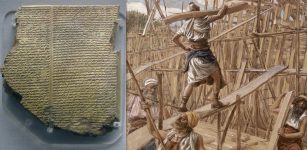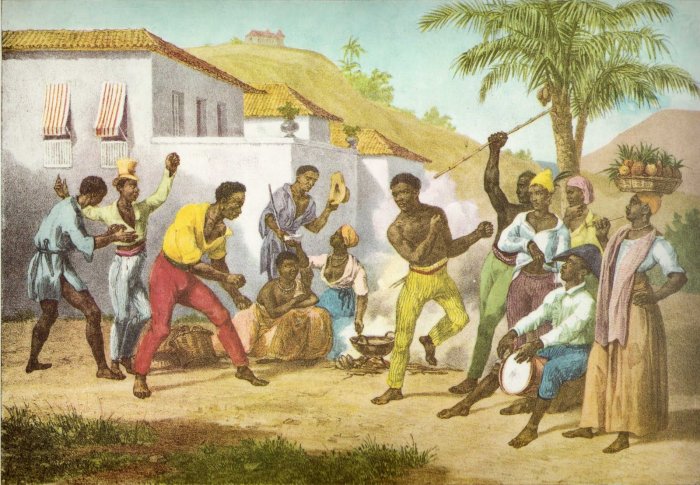Capoeira: Ancient Martial Art Disguised As A Dance Became A Symbol Of Resistance To Oppression
Ellen Lloyd - AncientPages.com - Capoeira is an unusual ancient martial art because it resembles more dancing than fighting. Capoeira was originally invented hundreds of years ago in Brazil by West African descendants.
Runaway slaves had to find a way to defend themselves against attackers, and that’s when Capoeira was born. Capoeira was banned due to its “dangerous nature.” As a result, practitioners disguised it as a dance by which it lives today.
Men train Capoeira on the beach. Credit: Adobe Stock - danillaophoto
Capoeira became a symbol of hope and resistance to oppression and a source of pride for the Brazilian people.
Tracing the history of Capoeira takes us to the 17th century and the beginning of African slavery in Brazil. It was a time when Portuguese colonists began exporting slaves to their colonies. Most of the slaves originated from West Africa. With its vast territory, Brazil received most of the slaves; almost 40% of all slaves were sent through the Atlantic Ocean.
Life for the slaves was difficult. They lived in ghettos where conditions were horrible. The poor slaves were forced to work hard and often suffered physical punishment for small misbehaviors.
Although slaves often outnumbered colonists, rebellions were rare due to a lack of weapons, harsh colonial law, disagreement between slaves coming from different African cultures, and lack of knowledge about the new land. All this, together, discouraged the slaves from launching a rebellion.
Capoeira or the Dance of War by Johann Moritz Rugendas, 1825, published in 1835
But then, one day, the ancient martial art we today call Capoeira was born. It became a symbol of hope and a tool of survival for slaves who escaped.
Slaves who managed to escape gathered together and established so-called quilombos, primitive settlements in far and hard-to-reach places.
The largest of these settlements was Quilombo dos Palmares, located in the state of Alagoas. It consisted of many villages which lasted more than a century. Quilombo dos Palmares had remarkable Capoeira fighters who managed to resist at least 24 small attacks and 18 colonial invasions.
Portuguese soldiers sometimes said that it took more than one dragoon (mounted infantry) to capture a quilombo warrior since they would defend themselves with a strangely moving fighting technique. The provincial governor declared it is harder to defeat a quilombo than the Dutch invaders.
Capoeira is an unusual ancient martial art because it resembles dance more than fighting. Credit: Marie-Lan Nguyen - CC BY 2.5
By the end of the 19th century, slavery came to an end in Brazil. This became a social problem because many free slaves had no jobs. Some started to use their knowledge of Capoeira in unconventional ways. Criminals and warlords used capoeiristas as bodyguards and hitmen. Groups of capoeiristas, known as maltas, raided Rio de Janeiro.
In 1890, Brazilian authorities banned Capoeira because of its dangerous nature. People who practiced Capoeira would be arrested, tortured, and often mutilated by the police.
This did not stop the ancient martial art that became disguised as a dance and is still practiced today. Skilled capoeiristas can even disguise an attack as a friendly gesture. Knowledge of this unusual ancient martial art spread, and nowadays, it is not only a martial art but an active exporter of Brazilian culture all over the world.
Updated on September 22, 22023
Written by Ellen Lloyd – AncientPages.com
Copyright © AncientPages.com All rights reserved. This material may not be published, broadcast, rewritten or redistributed in whole or part without the express written permission of AncientPages.com
More From Ancient Pages
-
 Ancient Egyptians Had The First Governmental Health Care System
Ancient History Facts | Jul 6, 2018
Ancient Egyptians Had The First Governmental Health Care System
Ancient History Facts | Jul 6, 2018 -
 Biblical Event Verified By Study Of Earth’s Magnetic Field?
Archaeology | Jan 4, 2024
Biblical Event Verified By Study Of Earth’s Magnetic Field?
Archaeology | Jan 4, 2024 -
 Advanced Ancient Knowledge Of Chemistry – From Chrome Plating To Nanotubes
Ancient Technology | Jun 12, 2019
Advanced Ancient Knowledge Of Chemistry – From Chrome Plating To Nanotubes
Ancient Technology | Jun 12, 2019 -
 Decebalus – The Brave One’ – Last Mighty King Of Dacian People
Featured Stories | Jun 23, 2022
Decebalus – The Brave One’ – Last Mighty King Of Dacian People
Featured Stories | Jun 23, 2022 -
![Photo taken on Dec 20, 2015 shows hoof-shaped gold ware unearthed from the main coffin in the Haihunhou (Marquis of Haihun) cemetery, East China's Jiangxi province. [Photo/Xinhua]](https://www.ancientpages.com/wp-content/uploads/2015/12/MarquisofHaihuntomb1-307x150.jpg) Does A 2,000-Year-Old Tomb Belong To Marquis of Haihun? – Search For His Seal Continues
Archaeology | Dec 25, 2015
Does A 2,000-Year-Old Tomb Belong To Marquis of Haihun? – Search For His Seal Continues
Archaeology | Dec 25, 2015 -
 Mysterious Lost Civilization Of Tiahuanaco – Uncomfortable Truth About One Of The World’s Oldest Cities
Ancient Mysteries | May 24, 2020
Mysterious Lost Civilization Of Tiahuanaco – Uncomfortable Truth About One Of The World’s Oldest Cities
Ancient Mysteries | May 24, 2020 -
 Earliest Evidence Of A 260-Day Maya Calendar Found Inside Guatemalan Pyramid
Archaeology | Apr 14, 2022
Earliest Evidence Of A 260-Day Maya Calendar Found Inside Guatemalan Pyramid
Archaeology | Apr 14, 2022 -
 On This Day In History: Edict Of Pistres ‘A New Law’ Against Viking Raids Issued – On July 25, 864
News | Jul 25, 2016
On This Day In History: Edict Of Pistres ‘A New Law’ Against Viking Raids Issued – On July 25, 864
News | Jul 25, 2016 -
 Something Never-Before-Seen Is Hidden Beneath 15 Giant Viking Burial Mounds Spotted By Radar In Norway
Archaeology | Jan 19, 2021
Something Never-Before-Seen Is Hidden Beneath 15 Giant Viking Burial Mounds Spotted By Radar In Norway
Archaeology | Jan 19, 2021 -
 Hidden Double Message Discovered On Ancient Clay Tablet Gives A Disturbing Account Of The Great Flood
Archaeology | Dec 5, 2019
Hidden Double Message Discovered On Ancient Clay Tablet Gives A Disturbing Account Of The Great Flood
Archaeology | Dec 5, 2019 -
 Remarkably Well-Preserved 2,500-Year-Old Canoe Discovered In Swiss Lake
Archaeology | Sep 16, 2023
Remarkably Well-Preserved 2,500-Year-Old Canoe Discovered In Swiss Lake
Archaeology | Sep 16, 2023 -
 Paleolithic Standing Bird Figurine – East Asian 3-D Art – Recovered From Refuse Heap
Archaeology | Jun 23, 2020
Paleolithic Standing Bird Figurine – East Asian 3-D Art – Recovered From Refuse Heap
Archaeology | Jun 23, 2020 -
 On This Day In History: Declaration Of Independence Of The Mexican Empire Is Drafted – On Sep 28, 1821
News | Sep 28, 2016
On This Day In History: Declaration Of Independence Of The Mexican Empire Is Drafted – On Sep 28, 1821
News | Sep 28, 2016 -
 Glory And Fall Of Babylon Dedicated To The Cult Of Marduk
Featured Stories | Oct 11, 2016
Glory And Fall Of Babylon Dedicated To The Cult Of Marduk
Featured Stories | Oct 11, 2016 -
 El Gigante Offers Lessons In Sustainability, Evolution And Human Adaptation, Courtesy Of The Holocene
Archaeology | Jun 29, 2023
El Gigante Offers Lessons In Sustainability, Evolution And Human Adaptation, Courtesy Of The Holocene
Archaeology | Jun 29, 2023 -
 Tree Rings On the Oregon Coast Show Evidence A Tsunami That Struck The Pacific Northwest In 1700
Archaeology | Sep 3, 2021
Tree Rings On the Oregon Coast Show Evidence A Tsunami That Struck The Pacific Northwest In 1700
Archaeology | Sep 3, 2021 -
 Exciting discoveries made by archaeologists in Laconia
News | Aug 25, 2015
Exciting discoveries made by archaeologists in Laconia
News | Aug 25, 2015 -
 Was Megalithic Stone Circle Of Mzoura The Tomb Of Giant Antaeus?
Civilizations | Sep 5, 2015
Was Megalithic Stone Circle Of Mzoura The Tomb Of Giant Antaeus?
Civilizations | Sep 5, 2015 -
 Suomenlinna Fortress: Impressive ‘Castle Of Finland’ Has Rich History
Featured Stories | Feb 13, 2016
Suomenlinna Fortress: Impressive ‘Castle Of Finland’ Has Rich History
Featured Stories | Feb 13, 2016 -
 Ancient DNA Yields Surprising Findings On World’s Earliest Seafarers
Archaeology | Jun 30, 2022
Ancient DNA Yields Surprising Findings On World’s Earliest Seafarers
Archaeology | Jun 30, 2022



